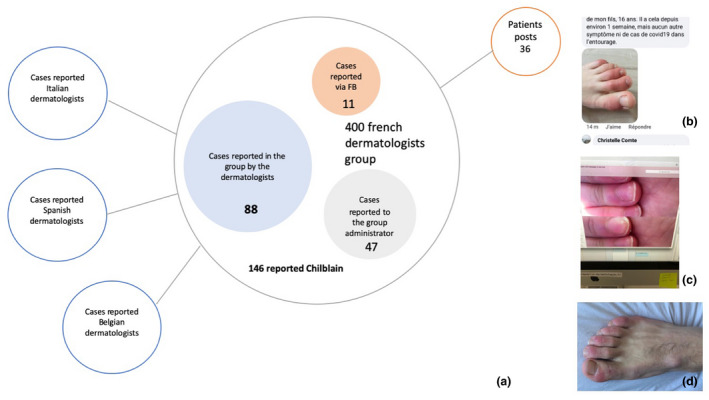Acknowledgements
The authors thank all the dermatologists of the French Union of Dermatologists and Venereologists SNDV, general practitioners, paediatricians, who provided data and pictures, and the patients involved in this study. Dr Charbel Skayem for his proof reading.
Editor
In March 2020, Europe became the epicentre of COVID‐19 pandemic. Several countries organized nationwide population containment, starting on March 9th in Italy and March 17th in France. 1 For the continuity of care and to avoid in person consultation and disease propagation, the French ministry of health released incentives to facilitate live interactive consultation for COVID and non‐COVID patients. 1 The French union of dermatologists created a text messaging group on WhatsApp® to share administrative information about teledermatology, as well as scientific reviews about the pandemic. In the dermatology field, publications related to COVID‐19 mostly focused on skin damages of healthcare workers, unspecific viral skin manifestation, and strategies to avoid virus transmission in dermatologists’ practices, favouring teledermatology implementation. 2 , 3 , 4 , 5
On the Whatsapp® group, which included four hundred dermatologists, atypical skin eruptions or lesions of suspected or confirmed COVID‐19 patients were posted. While some dermatologists were academics, most had private practices. We performed an analysis of all 295 cases submitted in this group from its creation date on March 14th till April 10th 2020. The first post was an atypical eruption of vesicles in a suspected COVID‐19 patient (Fig. 1). Then, after the first atypical hands eruption reported on March 23rd, an outbreak of chilblain‐like lesion was reported during the third week of containment in pauci‐symptomatic COVID‐19 patients (Fig. 1). On this Whatsapp® group, 74% (N = 219) of cases were shared for the first time by the members, 4% (N = 11) were re‐posted from a dermatologist Facebook® network, and 22% (N = 65) from the group administrator network. Chilblains or Chilblain‐like lesions represented 146 posts, and 149 posts included other suspected COVID19‐related skin eruption, for example, urticaria, rash, chickenpox‐like or pytiriasis rosea. A signal was also detected in other European physicians' networks, and 36 patients submitted their testimonials through the SNDV website (Fig. 2). The number of observed chilblain or chilblain‐like lesions during this pandemic is very unusual, especially in spring time and in patients confined at home. A previous case was reported in a child in Italy. Further studies are needed to establish the role of COVID‐19 in these lesions, but altered coagulation status, and micro‐thrombi observed in severe COVID‐19 patients are consistent with the observed lesions. This alert was pointed out through the SNDV messaging group. Since most of their practices were on hold, French dermatologists replaced in‐person consultation by live‐and‐ interactive consultation or store‐and‐forward teledermatology. This helped detect pauci‐symptomatic skin lesions in patients with pauci‐COVID symptoms managed by general physicians. This clinical presentation was not reported among skin manifestations in inhospital cases series. 3 Similar to anosmia, chilblain may be a symptom mainly reported in COVID‐19 outpatients, which supports the important role that dermatologists play in this outbreak control. 6
Figure 1.

Kinetic and timeline of clinical cases posted by the SNDV dermatologist group.
Figure 2.

Chilblain: Source of chilblain posts (a), Post on Facebook (b), Chilblain observed by teledermatology (c) and Chilblain (d).
COVID‐19 outbreak was first described by Dr Li Wenliang using WeChat®. Our observation highlights the strength of social networks or instant text messaging in healthcare providers' activity and the necessity of telemedicine implementation. This crisis urges countries to widespread telehealth adoption. 7 Finally, in the interest of time‐saving, social networks can be a platform for novel findings or unusual case reports sharing. 8 In the era of open access science, an expert moderator as well as an express reviewing of published cases are needed to avoid spreading of false or untrustworthy information. We strongly encourage learned societies and healthcare institutions to develop appropriate tools in the field for extraction or release of scientific information. This is a major challenge to limit physician isolation, provide continuous learning, and benefit from collective intelligence. It is time for interactive device‐mediated technologies that facilitate sharing of information to contribute to the increasing knowledge and expansion of skill‐sets in a new disease.
References
- 1. Ghanchi A. Adaptation of the National Plan for the Prevention and Fight against pandemic influenza to the 2020 COVID‐19 epidemic in France. Disaster Med Public Health Prep 2020; 7: 1–9. [DOI] [PMC free article] [PubMed] [Google Scholar]
- 2. Lan J, Song Z, Miao X et al. Skin damage among healthcare workers managing coronavirus disease‐2019. J Am Acad Dermatol 2020; 82: 1215–1216. [DOI] [PMC free article] [PubMed] [Google Scholar]
- 3. Recalcati S. Cutaneous manifestations in COVID‐ 19: a first perspective. J Eur Acad Dermatol Venereol 2020. 10.1111/jdv.16387 [DOI] [PubMed] [Google Scholar]
- 4. Radi G, Diotallevi F, Campanati A, Offidani A. Global coronavirus pandemic (2019‐nCOV): implication for an Italian medium size dermatological clinic of a ii level hospital. J Eur Acad Dermatol Venereol 2020. 10.1111/jdv.16386 [DOI] [PubMed] [Google Scholar]
- 5. Chen Y, Pradhan S, Xue S. What are we doing in the dermatology outpatient department amidst the raging of the 2019 novel coronavirus? J Am Acad Dermatol 2020; 82: 1034. [DOI] [PMC free article] [PubMed] [Google Scholar]
- 6. Eliezer M, Hautefort C, Hamel A‐L et al. Sudden and complete olfactory loss function as a possible symptom of COVID‐19. JAMA Otolaryngol Head Neck Surg 2020; in press. [DOI] [PubMed] [Google Scholar]
- 7. Ohannessian R, Duong TA, Odone A. Global telemedicine implementation and integration within health systems to fight the COVID‐19 pandemic: a call to action. JMIR Public Health Surveill 2020; 6: e18810. [DOI] [PMC free article] [PubMed] [Google Scholar]
- 8. Tang L, Bie B, Park S‐E, Zhi D. Social media and outbreaks of emerging infectious diseases: a systematic review of literature. Am J Infect Control 2018; 46: 962–972. [DOI] [PMC free article] [PubMed] [Google Scholar]


